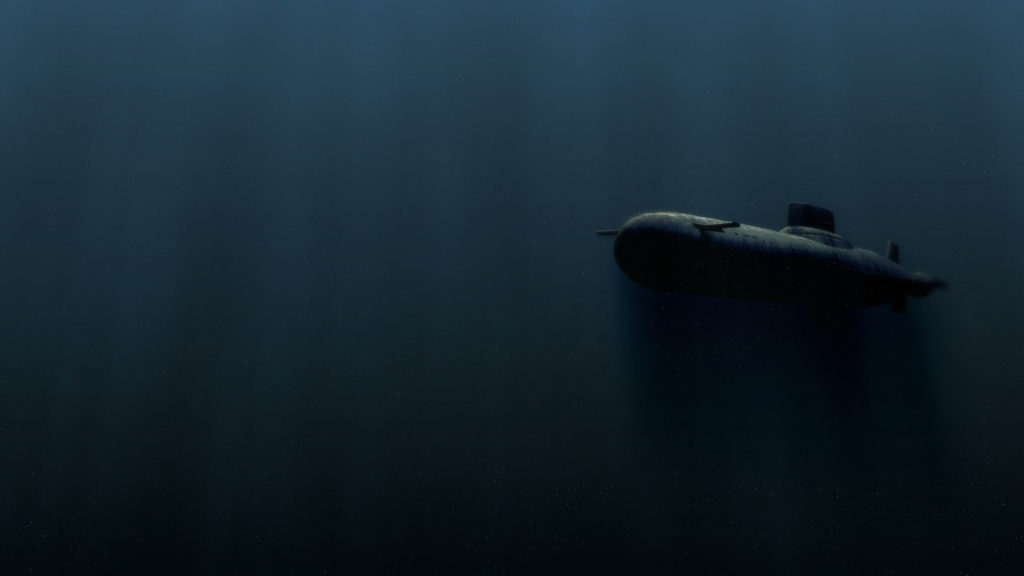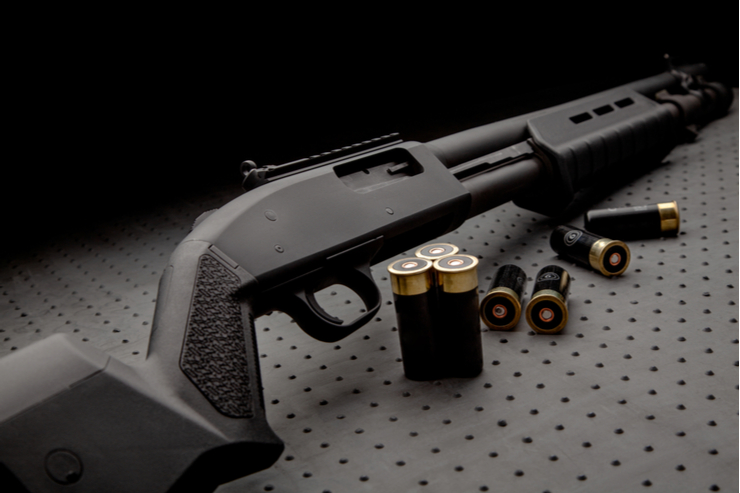
Miles off the California coast and deep under the ocean’s surface, the chase is on.
The prey: a submarine from a rogue nation caught raising its periscope earlier in the day. The pursuer: a U.S. Navy battle group armed with futuristic undersea technology.
With a bang and a burst of bubbles, a swarm of American undersea drones rockets out from an armored locker on the sea floor. They dart through the depths, following a digital trail pieced together from scraps of sensor data from a Triton unmanned plane, warships and a robotic Sea Hunter trimaran skimming the surface. One of the drones detects a slight shift in the Earth’s magnetic field – a sign the enemy is near. The swarm pings its sonars, each burst of sound carrying an implicit message: We found you. Now get out.
This is the vision for undersea warfare in the 21st century – a vast network of unmanned vehicles, smart weapons, sonars and software all working together to make the U.S. Navy’s traditional fleet of ships and submarines more powerful than ever.
The push to innovate comes as other nations deploy newer and more capable submarines. North Korea now has one of the world’s largest submarine fleets, and in April 2016 one of them test-launched a ballistic missile while submerged. China is expected to grow its submarine fleet by as much as 25 percent by the year 2020, and is developing better submarine-launched, anti-ship cruise missiles. Russian submarine patrols have increased an estimated 50 percent since 2013, and the country is investing billions to modernize its fleet.
“It’s getting to where other players can now build undersea warfare systems, and they can be effective enough. They’re not as good as U.S. systems, but they’re capable,” said Bryan Clark, a former U.S. Navy nuclear submariner and the author of a recent report on undersea warfare for the Center for Strategic and Budgetary Assessments. “New capabilities, powered by improved computer processing, cheaper computer processing, are making it so that the barrier to do undersea warfare is much lower. If we’re not smart about how we reshape or evolve our undersea forces, we can fall in to a situation where we fail to evolve, but the threat does.”
To meet that demand, a Raytheon team of engineers, former sailors and submariners is pushing the boundaries of several key technologies, including a specialized form of sonar, powerful data analytics, advanced sensors and the development of autonomous robots.
ROBOT SHIPS WITH SUPER HEARING
Sea Hunter, DARPA’s new robotic submarine-hunting vessel, sails during its christening in Portland, Oregon in early 2016. The vessel will carry Raytheon’s Modular Scalable Sonar System. (DARPA photo)
A shadowy gray trimaran sails down the Willamette River in Portland, Oregon. A few people stand on the deck to keep an eye on things, but that’s just for this test run. This is a true ghost ship – a crewless, all-robotic, submarine-stalking vessel dubbed Sea Hunter.
The ship, developed for the Defense Advanced Research Projects Agency, uses a powerful suite of sonars to carry out its missions. One of them, the Raytheon Modular Scalable Sonar System, will help it dodge mine fields and incoming torpedoes.
Sonars are key in this new era of undersea warfare, because radars can’t penetrate deep underwater.
Surface ships commonly hunt for submarines using sonars mounted on their hulls, but those have a major limitation: Submarines can hide under “acoustic shelves,” or the invisible, sound-blocking walls created by layers of water with differing densities and pressure.
To break through those barriers, the Navy is looking to outfit its fleet of littoral combat ships – versatile shallow-water fighters – with a technology known as variable-depth sonar. Instead of working from a fixed point on a ship’s hull, a variable-depth sonar would ride in tow, dipping under the surface and using a long, flexible tail to hear what’s happening down below.
“You put the right sensors in the right layer, and you’re right back in there,” said U.S. Navy Vice Adm. (Ret.) Richard W. Hunt, who now leads Raytheon’s business development for U.S. military and civil government agencies.
A Raytheon minehunting sonar called AN/AQS-20 uses a similar concept; a ship launches a vehicle that pulls the sonar along in the water while it looks for mines in front, below and all around – an area the Navy calls the “water column.” The sonar is part of the minehunting package aboard the U.S. Navy’s littoral fleet.
The Raytheon sonar on the Sea Hunter is not a variable-depth sonar. But it has another feature that is hugely valuable: an open computing architecture, meaning navies can tailor it to their needs easily.
“The reason it is so powerful and of interest to our customers is it comes with a developer’s kit. You can write your own applications. You can write code for it,” said Randy Brandenburg, senior director for strategic initiatives in the seapower division of Raytheon’s Integrated Defense Systems business. “A lot of it is based on tactics and operations unique to a navy, unique to a service. Some engage and interrogate targets different ways. This gives our customers freedom and flexibility.”
With a strong sonar reading, a trained sailor can tell the difference between a field of moored mines or a massive submarine lurking in the depths. A weaker signal, naturally, is less useful.
Unless, of course, you have powerful computing tools to help.
SHAZAM FOR THE SEA
The U.S. Navy plans to field dozens of MQ-4C Triton unmanned aircraft to patrol for submarines and other threats. Raytheon provides sensors for both the Triton and the P-8, the Navy’s newest maritime patrol planes.
Computers can read sound just like they can any other data – think of smartphone apps like Shazam that identify songs within seconds. The future of undersea warfare demands the same thing, only for sounds that are happening underwater, many miles away. With fast processors and advanced algorithms, sailors could use faint sounds to tell whether a far-off noise is a friend, a foe, or even a fish.
“As you can imagine, the more sophisticated the algorithm, the better chance of picking up the subtleties,” said Bruce Grooms, a retired U.S. Navy vice admiral who now works for Raytheon as vice president of Navy and Marine Corps programs.
The goal is to get more out of sonar data, then tie that intelligence into a larger network, Brandenburg said. Maritime patrol aircraft like the MQ-4C Triton and the P-8 – both of which carry Raytheon sensors – can contribute information as well.
This full picture is especially valuable when doing the dangerous, time-consuming work of clearing mines, Brandenburg said.
“The Holy Grail here is a sensor, an acoustic picture, where you can have positive confirmation it’s a mine, then I can go off and actually launch a next-generation (weapon) to go out and negate that mine, all at the same time,” he said. “Right now, that process may require up to three individual trips, which could take days or even weeks.”
While much of the scouting work is done by robots that work around the clock, the decision to act on the information – to launch a weapon at a mine or enemy ship, for example – would remain with humans. The Department of Defense calls that concept “human-machine teaming,” and it’s part of the DoD’s Third Offset technology strategy for countering tomorrow’s military threats.
HUNTING LIKE AN OCTOPUS
Raytheon and the Office of Naval Research are testing the tube-launched vehicle as a way to expand the submarine-hunting capability of the P-8 Poseidon plane
One Raytheon expert has been working for decades on the artificial intelligence that will enable these human-machine teams.
Jim Crowder builds robotic brains modeled after those of animals. First came the cockroach, whose brain has three neurons on each half and a communications hub called a prefrontal cortex. Now he’s working on a robotic octopus. That machine’s main brain sends broad commands to smaller sub-brains throughout the body that know the individual steps needed to complete the task.
For undersea warfare, the application is clear: think teams of robots that launch from a mother ship, venturing out to hunt mines or run reconnaissance missions. They would answer to a mediator – in this case, a sailor or submariner – but would know their jobs well enough to do them even if communications fail.
“Underwater communication is iffy at best,” Crowder said. “Particularly for underwater or deep space, (that) becomes extremely important – the notion of being able to continue the mission if you lose communication.”
When many unmanned vehicles work together, that’s called a swarm, and it’s a concept Raytheon and the Navy are pursuing for the Coyote unmanned aerial system. The Coyote was originally developed to fly into hurricanes from P-3 Orion weather planes. Now, Raytheon and the Office of Naval Research are testing the tube-launched vehicle as a way to expand the submarine-hunting capability of the P-8 Poseidon plane.
The idea is to equip the tiny planes with sensors that can read magnetic energy, then have them skim the surface for submarines and report to the Poseidon as it does other surveillance at higher altitudes.
“By being able to stay at altitude, (the Poseidon) can maintain other surveillance on an area while they’re potentially prosecuting a submarine,” said John Hobday, a retired Navy captain who now leads business development for Raytheon’s unmanned systems. “It’s an exciting thing for the Navy because it gives them a capability that doesn’t exist now.”
Coyote’s submarine-hunting potential is the latest development in Raytheon’s work with unmanned systems, but the company has been advancing that field of technology for years. Several years ago, scientists from Raytheon BBN Technologies helped develop what was essentially a portable sensor field to detect submarines in shallow water. The system consisted of about 40 robotic vehicles that swam down to a certain depth, spread out and listened for signs, all while sharing data with one another via an acoustic modem.
“As far as we know today, it is still the largest demonstration by far of an underwater wireless networking system,” said Jason Redi, who led Raytheon BBN’s part of the project. “It was quite the system.”
STASHING THE CACHE
Hydra aims to develop a distributed undersea network of unmanned payloads and platforms to complement manned vessels.
Self-reliant, robotic systems have another advantage: they can hibernate for months or years on the ocean floor until they are needed.
That’s the idea behind undersea platforms – lockers where commanders can stash sensors, unmanned vehicles, communications buoys, weapons and other technology, then deploy them when needed. DARPA began pursuing a system of undersea platforms called Hydra back in 2013.
“You could have sensors, you could have mines, you could have other types of weapons,” said Brian Stites, a former U.S. Navy submariner who now works for Raytheon. “You could put out packages for special ops teams to pick up. All types of things. It’s pretty cool.”
THE MULTITASKING TORPEDO
This illustration shows a Virginia-class submarine firing an MK 48 heavyweight torpedo. Raytheon engineers are developing technology that would enable torpedoes to do more, including reconnaissance missions and mapping the ocean floor.
New technology is also giving new abilities to combat-proven weapons like the torpedo.
For decades, the job of the torpedo has been pretty straightforward: Go after something and explode.
They’re a little bit like the missiles of the underwater realm. Which is exactly why Raytheon is doing with torpedoes what it has done with some of its missile systems – to pack them with technology that makes them do more. The possibilities include surveillance, reconnaissance, mapping of the ocean floor and measuring currents.
“What we really like is, this is the first time a torpedo is more than a torpedo,” Brandenburg said. “This is a perfect space for Raytheon because it takes advantage of our decades working with the undersea community. This is a real sweet spot.”
That kind of constant improvement and innovation will help maintain superiority undersea at a time when hostile nations are making huge strides in submarines and other technologies, Hunt said.
“The U.S. Navy is now in a position where they need to step up and deal with that and maintain a very strong posture of undersea dominance,” he said. “The serious game is back on.”
Source: Raytheon



